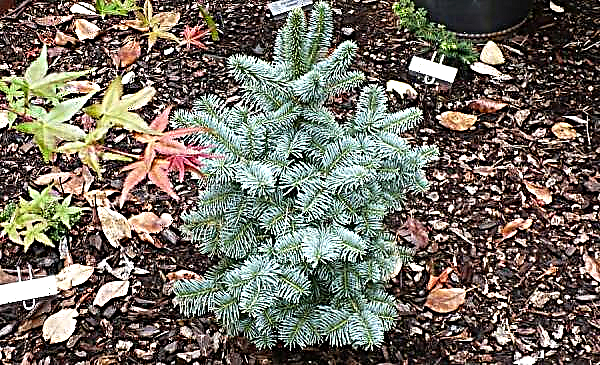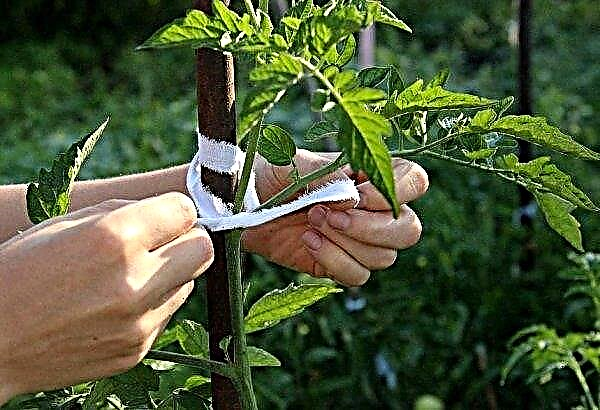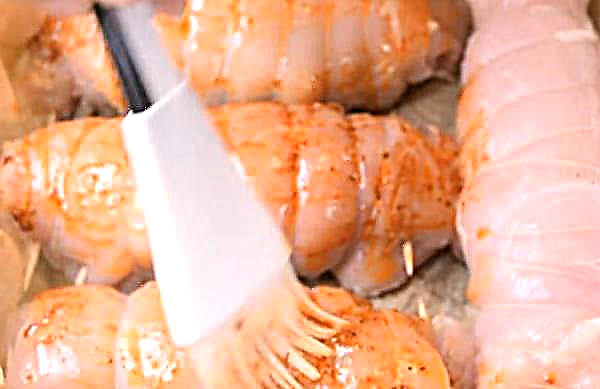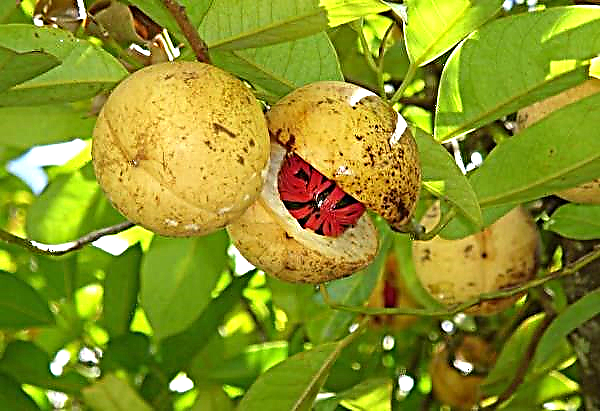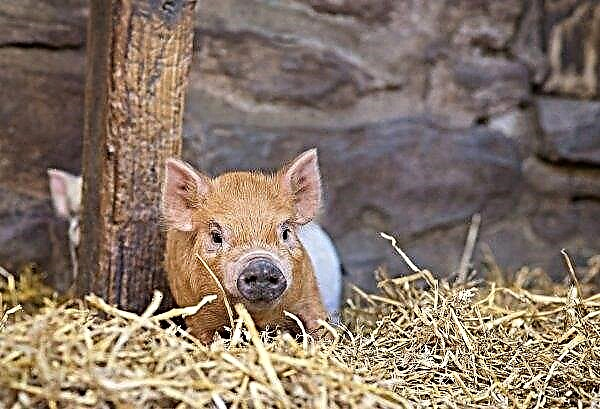A "tropical grove" can often consist of only one plant, which has several names - ficus bengal, banyan or bengal fig. In a natural habitat, the culture grows to enormous size and has many aerial roots, which later turn into trunks, and a domesticated banyan tree grows to a roof in three to five years. In this article we will talk about the organization of proper care in an apartment for this decorative representative of the tropical flora.
Botanical description of the plant
Ficus bengal (Ficus benghalensis) belongs to the species of evergreens from the genus Ficus and belongs to the Tutov family (Moraceae), whose native places are the tropics and extratropical regions with a monsoon climate (India, Asian countries, South China, etc.).
A characteristic feature of the species is a unique life form of a tree - a banyan tree, in which a single plant grows on a vast area, forming an entire forest. This is facilitated by the formation of its powerful aerial roots that appear on the horizontally directed branches of the ficus. Some roots dry up, while others tend to the ground, take root deeply, after which they become lignified and become bearing trunks, letting out side branches, so one banyan tree can occupy multi-hectare areas, forming a forest thicket with its ecosystem.Did you know? Bonsai lovers breed Bengal banyan, forming and giving it a resemblance to a small tree. For this, a wire matrix is used, on which the plant is attached and given his height and shape required direction.
Photo gallery
In nature, adult ficus reaches 40-meter growth. Oval or ovoid leaves also match their host - large, grow more than 25 cm in length, 14 cm in width. They have a leathery surface, color - dark green, with pronounced pale green veins. The ficus blooms with siconia (hollow rounded formations) with spherical inflorescences from soft yellow heterosexual flowers. It blooms in April-June, after which at the place of flowers inedible fruits for humans are formed - small berries 2-3 cm in size, bright orange in color. The fruits are very fond of eating monkeys and birds, which are carriers of banyan seeds.
The table describes the characteristic features of Bengal ficus:
| Root system | aerial |
| Stem | woody aerial root |
| Leaf shape | oval |
| Leaf color | dark green |
| Flower shape | spherical inflorescences |
| Flower color | pale yellow |
| Fruit shape | round |
| Fruit color | bright orange |
| The taste of fruit | inedible |
Growing conditions
A tropical banyan tree needs to arrange a number of suitable conditions to preserve its decorative effect.
Accommodation
Bengal figs in an apartment grow to 3 meters in height, so he needs a spacious room with high ceilings. The principles by which the culture is placed:
The principles by which the culture is placed:
- for a banyan tree, the best placement in the room is on the sunny side, while the light should be diffused;
- when a flowerpot is located near a window opening in the brightest time of the day, it is shaded from the burning rays of the sun with the help of blinds or a light curtain, which will help to avoid burns on the sheets;
- the plant should not suffer from a lack of lighting, as this causes leaf plates to fade and deform;
- in warm time, small flowers are put on a loggia or in a garden to adapt to temperature changes, as well as for air to enter the soil mixture in a container;
- with the first cool days, the banyan pot is returned to the room.
Temperature mode
Banyan need moderate temperatures and suitable containment conditions:
- the plant needs to organize a year-round ambient temperature - + 18 ... +25 ° C;
- ficus loves a microclimate with stable conditions, therefore it does not tolerate drafts with a low air temperature (it can already happen at +17 ° C that the sheet mass may drop);
- young plants are especially vulnerable to temperature changes, since their root system is weak and underdeveloped, so they can die due to hypothermia of the soil in a pot;
- high temperatures, in turn, also have a detrimental effect on the culture, mainly on the aerial part of the plant, which is why the leaves begin to fade and dry.

Air humidity
Bengal ficus does not tolerate low humidity indoors, a reaction to dry air will be the appearance of a brownish spot on the leaf plates, as well as their twisting and drying.
The following actions will help to avoid such problems:
- in winter, the culture is moved away from heating devices (without disturbing the light regime) in order to avoid overheating;
- wet moss or sand is placed in a pallet under the pot;
- if the ficus is small, in the summer you can often spray it with warm water from a spray bottle;
- a large plant is not sprayed, but an automatic humidifier is installed in the room;
- periodically refresh the leaves with a damp sponge, removing dust from them.
Important! Since Bengal banyan is growing at a fairly rapid pace, the restraining factor for this will be the content of the culture in a small container and the shortening of the roots during transhipment.
Home Care
In a room environment, figs should be regularly and moderately watered, dosed top-dressings should be applied in the correct way, and also shaping pruning and annual transplantation should be applied.
Watering
Ficus does not have a pronounced rest time, because of this, watering should be carried out according to the following rules:
- water the crop in moderation throughout the year, every 3-4 days, as the upper layers of the soil dry out in the container (2-3 cm). The main condition for such care is to prevent overflow or lack of water;
- the remaining fluid from the pallet must be drained, since its stagnation will lead to rotting of the root system and the development of fungal infection;
- insufficient watering can lead to dehydration of the tree;
- water for irrigation is suitable only standing and soft, room temperature.
Top dressing
Plant nutrition is carried out according to the following principles:
- from spring to the end of summer, using mineral fertilizers, as well as organic top dressing;
- in the summer, they are fed 1-2 times every 30 days with nitrogen-containing fertilizer ("Mr. Color Ficus", "Master Agro"), which also includes the necessary vitamins and nutrients;
- in the winter, they are fertilized once every 2 months with a preparation for non-flowering crops or they are given universal top dressing;
- mineral mixtures are used in low concentrations (50% concentration of the specified dose);
- the drug is first diluted in water, and only then poured under the plant.
Pruning
Forming pruning for Bengal ficus is a necessary procedure, because it gives the culture compact dimensions and a beautiful, magnificent crown. The plant itself tolerates formation quite well. 
Important! In order for the ficus not to look one-sided, pulling its trunk and leaves towards the light, the bush must be constantly rotated around its axis so that the crown can evenly absorb sunlight.
Transfer
For the first time, a transplant to a young plant is carried out after 2 years in the spring. Subsequently, due to the high growth rate (from 0.5 m to 1 m per year), the culture is transplanted annually.
Step-by-step technology for transplanting Bengal ficus:
- Choose a container 2-3 cm larger than the previous one.
- Prepare a nutrient substrate containing peat, sheet soil, humus, sand and clay (you can use a universal earthen mixture from the garden center).
- The transplant is carried out by the method of transshipment, cutting 1/3 of the root.
- Be sure to organize a drainage layer at the bottom of the container to drain excess fluid (from clay shards, expanded clay or tree bark).
- An adult tree is replanted once every 5 years.
- In the future, an adult plant is recommended to update 10 cm of the topsoil in a pot.

Breeding
There are two common ways to propagate Bengal figs:
- cuttings;
- seeds.
Cuttings
Cuttings are the easiest of the ways to propagate ficus, which is carried out in the spring. This will require the following steps:
This will require the following steps:
- With a sharp knife, the tops of trunks with 2-3 internodes are cut off.
- Milky secretions are removed from the sections and placed in water with the addition of Kornevin or in a substrate consisting of peat and sand.
- Seedlings are covered with a transparent plastic bag and left in a warm and bright place. Dividens root for several weeks.
- Seedlings with sprouted roots are placed in separate containers for further growth, after which they are provided with an acceptable banyan tree care.
Seeds
Reproduction of ficus using seeds involves sowing planting material in low containers with sand and peat substrate.
Did you know? Ficuses are able to absorb some harmful impurities from the environment (phenols, benzene, trichlorethylene), while saturating the room air with active substances that increase working capacity, mood and normalize a person’s sleep.
Sowing of seeds occurs according to the following technology:
- The soil in the tank is poured at a level slightly lower than the sides, a little moisten the substrate and slightly tamped.
- Evenly distribute the seed material (in rows or scatter).
- Sprinkle the seeds on top with a layer of soil (5 mm) and cover the glass plate with glass.
- Shoots appear after 4-8 weeks. Every 3-5 days, crops should be aired.
- After germination of seedlings, the plate is transferred to a brighter place (so that the sprouts do not stretch). The first sheets will appear in a month and a half.
- Transplanted seedlings to a permanent place after 3 months. When transplanting, make sure that the root neck remains at the same level.

Possible growing difficulties
Bengal figs are resistant to diseases, but due to improper care, the tree can be affected by diseases and even attack by parasites.
Common problems due to errors in the cultivation of ficus and their possible solutions:
- Ficus leaves may fade due to low indoor temperature (below +17 ° C). The solution will be to increase the temperature in the room to + 20 ... +25 ° C, or transfer the culture to a room with an acceptable temperature.
- Stretching plants and chopping leaves. It happens due to lack of light. The bush needs to ensure a sufficient supply of scattered ultraviolet radiation or place a phytolamp near the bush (especially in winter).
- The appearance of yellow spots on the sheets due to the frequent overflow of the plant. It is necessary to change the substrate in the container, and adjust the irrigation rate.
- Slowed growth of the bush, pale leaves. Occurs due to a lack of minerals in the soil mixture. The problem is solved by replacing the substrate in the pot with a more nutritious one and observing the feeding schedule.
- Brown spots are observed along the edges of the leaves. The reason may be excessively dry air in the room, high ambient temperature or overfeeding with fertilizers. The problem of dry air is solved by regular spraying of the plant. If the plant is hot, it is transferred to a cooler place while maintaining a sufficient amount of light. In the case of an excess of fertilizing in the pot, the substrate changes, after which the correct feeding schedule is applied.
- The defeat of the leaves by a spider mite, scab, aphid and mealybug. It happens due to the long stay of ficus in warm and dry conditions. If parasites are found, the plant must be exposed to a warm shower to wash off insects. Also, wipe each sheet with a sponge dipped in a solution of laundry soap. After water procedures, the bush is carefully treated with suitable preparations (Fitoverm, Vertimek, Antitlin, etc.).
- Fungal diseases, root rot. They occur due to prolonged non-compliance with the rules and standards of the plant. In this case, the plant is not treated, but destroyed along with the container.
 If Bengal ficus is organized with proper care with a moderate level of moisture, sufficient diffused lighting, and watered and fed properly, this outlandish plant will settle in your apartment for a long time, all year round pleasing to the eye with fresh green leaves and bizarre stems.
If Bengal ficus is organized with proper care with a moderate level of moisture, sufficient diffused lighting, and watered and fed properly, this outlandish plant will settle in your apartment for a long time, all year round pleasing to the eye with fresh green leaves and bizarre stems.

